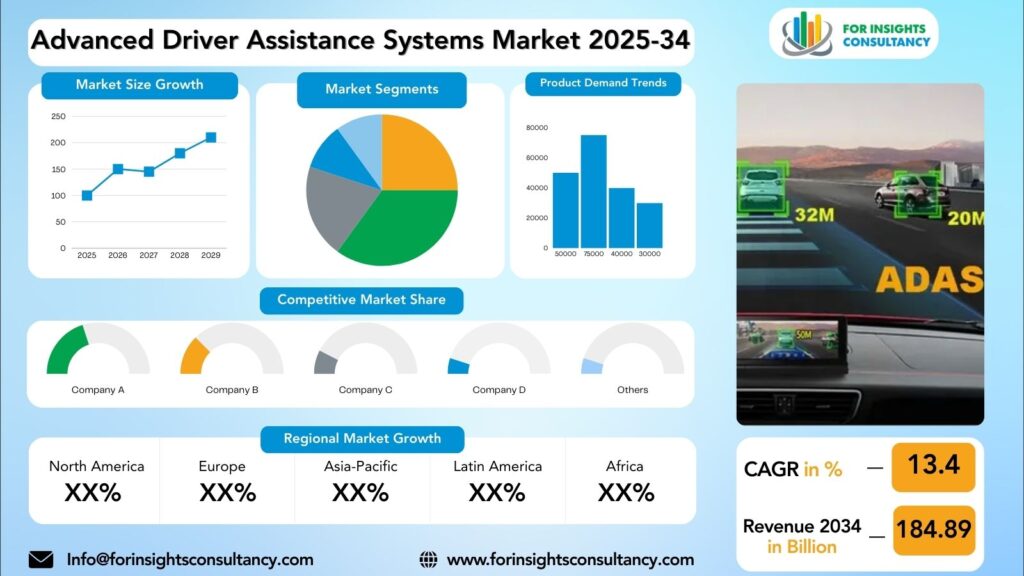
Advanced Driver Assistance Systems Market Research Report by System Type (Adaptive Cruise Control (ACC), Automatic Emergency Braking (AEB), Lane Departure Warning (LDW), Blind Spot Detection (BSD), Park Assist, Driver Monitoring System (DMS), Night Vision System, Cross-Traffic Alert), By Component (Hardware (Sensors, Processors), Software, Services), by Technology/Sensor Type (Camera, Radar, LiDAR, Ultrasonic), by Vehicle Type, by Level of Autonomy, and Region Global Market Analysis and Forecast, 2025-2034
Sep-2025 Formats | PDF | Category: Automotive | Delivery: 24 to 72 Hours
Advanced Driver Assistance Systems Market is forecast to increase from USD 46.8 Billion in 2025 to USD 184.89 Billion by 2034, at a CAGR of 13.4%.
Advanced Driver Assistance Systems Market: A Comprehensive Overview and Future Developments
The automotive industry has seen significant advancements in Advanced Driver Assistance Systems (ADAS), which utilize advanced sensors, cameras, and artificial intelligence algorithms to enhance vehicle safety and improve driving experiences. These systems, such as adaptive cruise control, lane departure warning, automatic emergency braking, and blind-spot detection, assist drivers in operating their vehicles safely and efficiently.
As ADAS technologies continue to evolve, they are becoming more sophisticated, detecting potential hazards in real-time and responding to them in real-time. The future of the ADAS market is promising, with continued advancements in sensor technology, connectivity, and artificial intelligence.
Developers are focusing on enhancing vehicle-to-everything (V2X) communication to improve safety and traffic efficiency. The integration of ADAS features into electric and connected vehicles is expected to drive further market growth, with increased demand for these systems across different vehicle segments. As consumers become more aware of the benefits of ADAS technologies, the market for ADAS is expected to grow.
Advanced Driver Assistance Systems Market Dynamics
Growth Drivers
The ADAS market is driven by the increasing demand for safety features in vehicles, such as adaptive cruise control, lane departure warning, and collision avoidance systems. This growth is driven by the rise in road accidents and fatalities, which has led to a focus on implementing advanced safety technologies to enhance driver and passenger safety. ADAS systems provide the necessary infrastructure and support for autonomous driving capabilities, and as technology continues to evolve, the demand for ADAS systems is expected to grow exponentially.
Government regulations and safety standards are also driving the adoption of ADAS systems in vehicles. Many countries have implemented strict regulations, including mandatory inclusion of certain ADAS features in new vehicles, aiming to improve road safety and reduce accidents. As a result, automotive manufacturers are increasingly incorporating ADAS technologies into their vehicles to comply with these regulations.
The integration of artificial intelligence and machine learning technologies in ADAS systems is revolutionizing the automotive industry. These technologies enable vehicles to analyze and process large amounts of data in real-time, making split-second decisions to improve driver safety and performance. By harnessing the power of AI and machine learning, ADAS systems can adapt to changing road conditions, identify potential hazards, and provide proactive assistance to drivers, driving the market forward and opening up new possibilities for future automotive innovation.
Restraints
The ADAS market faces several challenges, including cost, interoperability, regulatory hurdles, consumer awareness, reliability, and trust. The high cost of implementing advanced sensors, cameras, and software can make it difficult for some consumers to afford vehicles equipped with these technologies. Additionally, retrofitting older vehicles with ADAS can be costly, further limiting adoption. The lack of interoperability between different systems and manufacturers can create compatibility issues and limit the effectiveness of ADAS technologies. Regulatory hurdles, such as varying regulations and standards across regions, and concerns around data privacy and security complicate regulatory compliance. Consumer awareness of ADAS technologies is growing, but many still lack a clear understanding of their benefits, leading to skepticism and reluctance to adopt them. Reliability and trust are also key restraints, as accidents or malfunctions can erode consumer trust and slow down market adoption.
Opportunities
The Advanced Driver Assistance Systems (ADAS) market presents significant opportunities for providers to enhance vehicle safety, particularly with the increasing focus on road safety and decreasing accident rates. The integration of ADAS technology in electric vehicles can improve driving experience and efficiency. The advancement of Artificial Intelligence can lead to smarter, more efficient ADAS solutions that adapt to various driving conditions. Strategic partnerships with automotive OEMs can also open new avenues for ADAS providers to integrate their technology into various vehicles. However, challenges such as data security, regulatory compliance, and consumer acceptance of autonomous driving technologies need to be addressed. To succeed, companies must focus on innovation, quality, and customer experience, staying ahead of technology advancements and market trends.
Challenges
The implementation of Advanced Driving Assistance Systems (ADAS) technology in vehicles can be costly, particularly for lower-income individuals. The cost of sensors, cameras, and software can quickly add up, making it difficult for them to afford these systems. Manufacturers are working to reduce costs, but this remains a significant challenge. Interoperability is another challenge, as there is a lack of standardization among different systems, making it difficult for vehicles to communicate effectively. Manufacturers are working to create common protocols for better interoperability. Cybersecurity concerns are also a concern as vehicles become more connected, increasing the risk of cyber attacks. Manufacturers are investing in cybersecurity measures to prevent these attacks. Driver education is another challenge, as many drivers are unfamiliar with ADAS technology, leading to potential misuse. Manufacturers are providing more training and resources for drivers, but changing behaviors can be slow. To address these challenges, manufacturers are implementing cost reduction initiatives, collaborating with industry groups to create common standards for ADAS systems, improving interoperability and safety on the road.
Advanced Driver Assistance Systems Market Top Companies Covered In This Report:
Evaluate The Strategic Positioning And Innovation Pipelines Of Leading Market Companies-From Multinational Enterprises To Disruptive Regional Firms. Understand How Key Players Are Innovating, Expanding, And Capturing Value, And Use Competitive Benchmarks To Plan Your Next Move.
- Mobileye (Israel)
- Aptiv (Ireland)
- Valeo (France)
- Hyundai Mobis (South Korea)
- NVIDIA Corporation (US)
- Robert Bosch GmbH (Germany)
- Continental AG (Germany)
- ZF Friedrichshafen AG (Germany)
- Denso Corporation (Japan)
- Magna International Inc. (Canada)
- NXP Semiconductors (Netherlands)
- Autoliv (Sweden)
- Astemo Ltd. (Japan)
- Horizon Robotics Inc. (China)
- Advanced Micro Devices, Inc. (US)
Advanced Driver Assistance Systems Market News
Mobileye
In July 2025, Mobileye introduced a new driver monitoring system that integrates with its ADAS on a single chip, reducing costs and complexity for automakers.
In February 2025, the company unveiled a new line of electronic control units (ECU) designed for modularity, allowing automakers to scale from basic ADAS to full autonomous systems with greater flexibility.
Continental
At CES 2025, Continental showcased several innovations, including a new AI-supported night vision camera that significantly improves image quality in the dark, and its “Intelligent Vehicle Experience” demo car, which integrates various ADAS and in-cabin technologies.
NVIDIA
In August 2025, NVIDIA’s Jetson Thor platform, a powerful AI “brain” for vehicles, was launched. It offers a significant boost in AI performance and is designed to handle the massive streams of sensor data from cameras, LiDAR, and radar for ADAS and autonomous driving.
NVIDIA’s research group published papers at conferences like CVPR and RSS in 2025, focusing on key ADAS challenges such as real-time sensor fusion, data scaling laws for end-to-end autonomous driving, and closed-loop supervised fine-tuning of AI models.
Segmented View of the Industry:
The Advanced Driver Assistance Systems Market Is Mapped Through A Multidimensional Lens-Tracking Shifts Across Product Type, Applications, And Geographic Regions. This Segmented Approach Enables Businesses To Localize Their Growth Plans And Align Offerings With The Most Profitable Demand Centers.
Segmentation by System Type
- Adaptive Cruise Control (ACC)
- Automatic Emergency Braking (AEB)
- Lane Departure Warning (LDW)
- Blind Spot Detection (BSD)
- Park Assist
- Driver Monitoring System (DMS)
- Night Vision System
- Cross-Traffic Alert
Segmentation by Component
- Hardware (Sensors, Processors)
- Software
- Services
Segmentation by Technology/Sensor Type
- Camera
- Radar
- LiDAR
- Ultrasonic
Segmentation by Vehicle Type
- Passenger Vehicles
- Commercial Vehicles
Segmentation by Level of Autonomy
- Level 1
- Level 2
- Level 3
- Level 4
- Level 5
Global Geographic Coverage:
The Report Provides In-Depth Qualitative and Quantitative Data On the Advanced Driver Assistance Systems Market For All Of The Regions And Countries Listed Below:
North America
North America is a leading region in the adoption of Advanced Driver Assistance Systems (ADAS), with the United States, Canada, and Mexico being key players. The United States has been at the forefront of ADAS innovation, with major automotive manufacturers incorporating these systems into their vehicles. The country’s stringent safety regulations have prompted widespread adoption of ADAS technologies, such as lane departure warning systems and adaptive cruise control. Canada has also embraced ADAS, focusing on improving road safety and reducing accidents. The Canadian government has been proactive in promoting the use of ADAS technologies, leading to a growing market for these systems. Mexico is also gaining traction as consumers become more aware of the benefits of ADAS technologies. The Mexican automotive industry is rapidly evolving, with manufacturers incorporating advanced safety features into their vehicles. As the demand for safer and more efficient driving solutions grows, Mexico is poised to become a key market for ADAS.
Europe
The United Kingdom, Germany, France, and Italy are leading the way in the Advanced Driver Assistance Systems (ADAS) market, with the UK, Germany, France, and Italy being key players in the innovation and technology. The UK has seen a steady increase in the adoption of ADAS systems due to government initiatives and the presence of major automotive manufacturers. Germany, known for its robust automotive industry, is a major player in the global market due to its strong emphasis on research and development. France is also making significant strides in the ADAS market, focusing on enhancing road safety and reducing accidents. The country has introduced stringent regulations mandating the use of certain ADAS features in vehicles, driving the demand for advanced safety systems. Italy, known for its rich cultural heritage, is also becoming a key player in the ADAS market, with its automotive manufacturers investing heavily in R&D to develop state-of-the-art ADAS solutions. Europe is experiencing significant growth in the ADAS market, with the future looking promising for the industry.
Asia Pacific
China is driving the growth of the Advanced Driving Assistance Systems (ADAS) market, driven by the increasing demand for advanced safety features in vehicles. The Chinese government’s emphasis on road safety and stringent safety regulations have driven the growth of ADAS technologies in the country. Key players like Huawei and Baidu are investing heavily in research and development to enhance ADAS capabilities. The increasing number of vehicles on Chinese roads and the demand for luxury vehicles equipped with high-end ADAS features are further fueling market growth. Japan, known for its technological innovations in the automotive industry, is at the forefront of ADAS development. Leading automakers like Toyota and Honda are integrating advanced safety features into their vehicles to cater to the growing demand for safer driving experiences. South Korea is rapidly embracing smart mobility solutions, with automakers like Hyundai and Kia investing in advanced driver assistance systems to enhance vehicle safety and performance. The South Korean government’s initiatives to promote electric vehicles and autonomous driving technologies are driving the adoption of ADAS in the country.
Middle East and Africa
The Middle East is experiencing a surge in the adoption of Advanced Driving Assistance Systems (ADAS) due to increased road safety awareness and strict regulations. Countries like Saudi Arabia, United Arab Emirates, and Qatar are leading the way in implementing ADAS systems in vehicles. Saudi Arabia’s Vision 2030 initiative has emphasized the use of advanced safety features, leading to a surge in demand for ADAS systems. The United Arab Emirates is also a key market for ADAS technologies, with government regulations mandating the inclusion of safety features in vehicles. Safety-conscious consumers are increasingly opting for vehicles equipped with advanced driver assistance systems.
In Africa, the adoption of ADAS technologies is gaining momentum, driven by the need to enhance road safety and mitigate accident impacts. Countries like South Africa, Nigeria, and Kenya are emerging as key markets for ADAS solutions. South Africa is a prominent market for ADAS systems due to its focus on reducing road accidents and improving vehicle safety standards. The government’s proactive enforcement of safety technology regulations has led to an increase in ADAS features in vehicles across the country. Nigeria is also experiencing a rise in ADAS adoption due to increasing awareness about the benefits of safety features in vehicles. The market is expected to witness steady growth as more consumers recognize the importance of investing in vehicles equipped with advanced safety technologies.
Reasons to Buy:
- The Research Would Help Top Administration/Policymakers/Professionals/Product Advancements/Sales Managers And Stakeholders In This Market In The Following Ways.
- The Report Provides Advanced Driver Assistance Systems Market Revenues At The Worldwide, Regional, And Country Levels With A Complete Analysis To 2034 Permitting Companies To Analyze Their Market Share And Analyze Projections, And Find New Markets To Aim For.
- To Understand The Most Affecting Driving And Restraining Forces In The Market And Their Impact On The Global Market.
- Major Changes And Assessment In Market Dynamics And Developments.
- The Objective Of The Advanced Driver Assistance Systems Market Report Is To Identify New Business Opportunities Using Quantitative Market Forecasts.
- Formulate Sales And Marketing Strategies By Gaining An Understanding Of Competitors, Their Positioning, And Strengths & Weaknesses.
Faq – What Global Leaders Are Asking
What Is The Growth Prospect For The Advanced Driver Assistance Systems Market By 2034?
Advanced Driver Assistance Systems Market Is Expected To Achieve A Stable Growth Rate With A Compound Annual Growth Rate (Cagr) Of About 13.4% From 2025 Through 2034.
What Is Driving The Growth Of The Advanced Driver Assistance Systems Market?
The ADAS market’s growth is driven by increasingly stringent government regulations and safety mandates, which make systems like automatic emergency braking and lane departure warnings standard. This is coupled with rising consumer awareness and demand for enhanced vehicle safety and convenience features, pushing automakers to integrate more sophisticated technologies.
Who Are The Key Players In The Advanced Driver Assistance Systems Market, And What Are Their Market Shares?
The Advanced Driver Assistance Systems Market Includes Major Companies Like Mobileye (Israel), Aptiv (Ireland), Valeo (France), Hyundai Mobis (South Korea), NVIDIA Corporation (US), Robert Bosch GmbH (Germany), Continental AG (Germany), ZF Friedrichshafen AG (Germany), Denso Corporation (Japan), Magna International Inc. (Canada), NXP Semiconductors (Netherlands), Autoliv (Sweden), Astemo Ltd. (Japan), Horizon Robotics Inc. (China), Advanced Micro Devices, Inc. (US), Others.
Specific Market Share Data Is Not Publicly Available and Is Typically Provided In Detailed, Proprietary Market Research Reports.
Which Regions Are Leading the Advanced Driver Assistance Systems Market Growth?
The Asia-Pacific region is the clear leader in the ADAS market, driven by a high volume of vehicle production, growing consumer awareness, and the implementation of stricter safety regulations in countries like China and India. Europe also holds a significant market share, propelled by long-standing safety mandates and a strong focus on high-end, technologically advanced vehicles.
Customization: We Can Provide Following Things
1) On Market More Company Profiles (Competitors)
2) Data About Particular Country Or Region
3) We Will Incorporate The Same With No Additional Cost (Post Conducting Feasibility).
Any Requirement Contact Us: Https://Www.Forinsightsconsultancy.Com/Contact-Us/
Table of Contents
For TOC Contact us: https://forinsightsconsultancy.com/contact-us/







